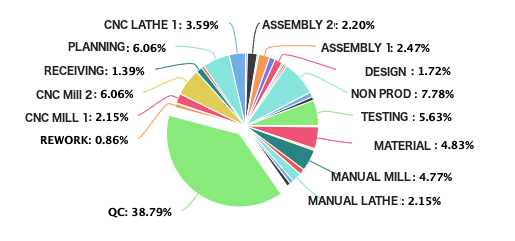Manufacturing and AI are two words that frequently come together nowadays, especially now that manufactures are looking to be leaner and more efficient. However, despite the hype you see on your newsfeed, it’s actually quite a challenging task to fulfill. The good news is, as how the AI technologies have improved dramatically, almost every single aspect of your shop floor issues has a corresponding AI algorithm that suits it. The bad news is, it takes a lot more than the technologies to fully utilize the power of AI – usually to change the shop floor culture is the hardest one. Given the success and failure stories we have seen so far, we will address the right way to introduce AI to the shop floor and how to make everyone benefit from it.
What can AI predict?
There are many exciting AI developments especially in the manufacturing world. Predictive maintenance has been a hot topic and the use of it continues to grow. However, despite the popularity of the topic, it’s not universally welcomed on the shop floor. The reason is simple – if the AI tells you, as a shop floor manager, there’s 70% of chance machine A will go down in a month, do you spend $20000 on a maintenance that’s not due? For some, the answer might be yes, but it’s clear why some people may be hesitant.
In general, a useful shop floor AI algorithm works the best when – 1. it’s solving a problem that the shop floor is concerned with. 2. the facility does not get punished, especially financially, for utilizing the information the AI provides. Take GPS navigation algorithms for example, following Google Maps or Apple Maps’ routes allow you to get from point A to point B faster, but you do not suffer any financial loss or physical damage if you were to ignore the directions they provide. Similar logic applies to the shop floor as well. Manufacturing AI really shines in some productivity improvement territories –
- Give more accurate quotes
- Shorten machining/QA time
- Improve profitability
Here’s an example of using AI for the above purposes. Given the shop floor management data, AI can determine the future job efficiency from the current job efficiency:

In this example, we know that the quoted job actually takes 2.48X to finish. If the quote was given not considering this factor, the facility looses money. The question is – if you are to give a quote for an upcoming job for the same part, do you use 2.48X as the factor? The AI is actually able to analyze the whole shop floor data and give a projected value to use. Is it accurate? The following is a good example to showcase.
AI prediction v.s. What actually happened
When using AI to predict future production efficiency, it’s able to provide a good understanding and analytical approach to what contribute to the efficiency. Naturally, that provides a deep understanding of what potential bottlenecks are waiting ahead. In this case, the AI identifies that QC will be the biggest reason for future delay. When we collect data 30 days after the analysis was made, it turned out to be true. When the analysis was made, QC is taking 50% of the planned time without obvious signs that there will be delays. However, the AI is able to pick up all the subtle signals and accurately identify that a future bottle neck was waiting ahead.
“How?” You might ask. One of the strong suits of AI is to identify subtle implicit correlations that are hard to identify with human eyes. I like to compare it to an experience manager’s intuition. An overly-simplified example can be like this: an operator that always has low efficiency on a Friday afternoon. When he’s rotated from planning to QC, the AI will pick up some risk of delay that may happen in the QC department.


Of course, the details of the AI algorithm goes deeper than that. Another example that we have found useful is also by looking at the future delay per client. In this case, jobs for CLIENT 1 also shows no past delays but the AI picks up potential future inefficiency that was later verified to be accurate.


How to integrate?
When there’s data, there’s AI. The minimum data requirement that manufacturing AI requires is the equipment utilization data, which can come from machine monitoring measurement or job scanning records. To allow the AI to match the execution against planned, we would need to include the job planning data as well – this can come from forms such as Excel, ERP, or quoting software.
Will it work for my shop floor?
The fundamental reason that makes shop floor AI work or fail is how you integrate and manage operator training. As soon as operators understand how the AI helps with their day-to-day operations, the fear about job security can be eliminated. There are some good examples and exciting results from shop floor AI that can be interesting reads learn more.
Mata Knowledge